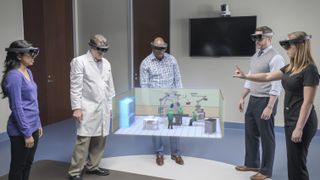HoloLens Heads To The Operating Room

For as much as many are focused on the gaming and consumer-level productivity potentialities of XR, much of the progress in the field is happening in other markets, like industry and medicine. To wit, Microsoft announced that it’s partnering with a medical technology company called Stryker to use HoloLens to design better operating rooms.
In a blog post, Microsoft explained that, “Everything from lighting, to equipment, tools, and even patient orientation, varies depending on who is using the operating room at any given moment. Equipment placement is critical as it effects [sic] ergonomics, efficiency, and task load, all of which have the potential to burden staff and slow procedures.”
To design better operating rooms, the company said, heads of multiple surgical disciplines need to physically meet to solve these issues, and a 3D design environment can help them do so much more efficiently. The post also stated:
Recognizing that the current model of operating room design needs to be evolved from 2D to 3D, and knowing that the needs of these specialties can be quite divergent, Stryker has found a way to design a shared operating room that can accommodate all surgical disciplines in a far more efficient manner.
The project is called ByDesign, and the idea is that people can rapidly mock up operating rooms, replete with all the necessary surgical equipment, and all parties can view it in 3D via HoloLens.
The post mentioned other healthcare use cases, including one called VimedixAR, which creates ultrasound simulations to learn safer ways of conducting the procedure. Medical researchers at Case Western Reserve University and the Cleveland Clinic are also using HoloLens to train doctors on human anatomy.
There are numerous other ways the medical field may benefit from using holograms to solve problems and learn techniques, and those can be paired with other new XR-like tools, as well. For example, the University of Missouri’s Immersive Visualization Lab is using motion capture to look at how doctors can be more efficient in operating and examination rooms--an effort that would seem to closely fit with Stryker’s ByDesign work.
Stay on the Cutting Edge
Join the experts who read Tom's Hardware for the inside track on enthusiast PC tech news — and have for over 25 years. We'll send breaking news and in-depth reviews of CPUs, GPUs, AI, maker hardware and more straight to your inbox.
-
Rheotome This is valuable design tool for many different industries. In my experience, MANY program managers simply could not read a drawing, and when shown drawings would approve a design and then complain about it when it actually showed up as hardware.Reply
Getting them on the same page before parts are built is a huge advantage. -
bit_user ReplyThe post mentioned other healthcare use cases, including one called VimedixAR, which creates ultrasound simulations to learn safer ways of conducting the procedure.
Of course, some of the most obvious use cases are actually visualizing ultrasound and MRI data, in 3D.
In fact, with a tracked ultrasound wand, you could put on a Hololens and see the baby right inside the mother. Within the limits of ultrasound's accuracy, obviously.
Most Popular


